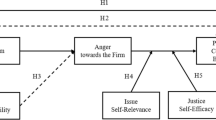Abstract
The literature on piracy has questioned the role of regulatory enforcement in the form of monitoring in deterring piracy. This article shows that for a wide range of penalty levels the equilibrium monitoring rate is such that it is optimal for the copyright holder to prevent piracy by expanding his output beyond the monopoly output level rather than producing the monopoly output level and investing in an anticopying technology. This result holds even when the monitoring cost is “sufficiently” high relative to the cost of investing in anti-copying technology.
Similar content being viewed by others
References
Andrés A. R. (2006) The relationship between copyright software protection and piracy: Evidence from Europe. European Journal of Law and Economics 21: 29–51
Bae S. H., Choi J. P. (2006) A model of piracy. Information Economics and Policy 18(3): 303–320
Banerjee D. S. (2006a) Lobbying and commercial software piracy. European Journal of Political Economy 22: 139–155
Banerjee D. S. (2006b) Enforcement sharing and commercial piracy. Review of Economic Research on Copyright Issues 3(1): 83–97
Banerjee D. S., Banerjee T., Raychoudhuri A. (2008) Optimal enforcement and anti-copying strategies to counter copyright infringement. Japanese Economic Review 59(4): 519–535
Burke A. E. (1996) How effective are international copyright conventions in the music industry?. Journal of Cultural Economics 20: 51–66
Chen, Y., & Png, I. (1999). Software pricing and copyright: enforcement against end-users. SSRN working paper series.
Cheng H. K., Sims R. R., Teegen H. (1997) To purchase or pirate Software: An empirical study. Journal of Management Information Systems 13(4): 49–60
Conner K. R., Rumelt R. P. (1991) Software piracy: An analysis of protection strategies. Management Science 37(2): 125–137
Duchene A., Waelbroeck P. (2006) The legal and technological battle in the music industry: Information-push versus information-pull technologies. International Review of Law & Economics 26(4): 565–580
Jaisingh J. (2009) Impact of piracy on innovation at software firms and policy implications for piracy policy. Decision Support Systems 46: 763–773
Nascimento F., Vanhonacker W. R. (1988) Optimal strategic pricing of reproducible consumer products. Management Science 34(8): 921–937
Novos I. E., Waldman M. (1984) The effects of increased copyright protection: An analytic approach. Journal of Political Economy 92(2): 236–246
Noyelle, T. (1990). Computer software and computer services in five asian countries. In United Nations Conference on Trade and Development/ United Nations Development Programme (UNCTAD/UNDP), Services in Asia and the Pacific: Selected Papers. (Vol. 1). New York: United Nations.
Papadopoulos T. (2003) Determinants of international sound recording piracy. Economics Bulletin 10: 1–9
Park W. (2001) Intellectual property and economics freedom. In: Gwartney J., Lawson R. (eds) Economic Freedom of the World. Fraser Institute, Vancouver
Park, Y., & Scotchmer, S. (2005). Digital rights management and the pricing of digital products, NBER working paper 11532.
Piquero N. L., Piquero A. R. (2006) Democracy and intellectual property: Examining trajectories of software piracy. The Annals of the American Academy of Political and Social Science 605: 104–127
Qiu L. D. (2006) A general equilibrium analysis of software development: Implications of copyright protection and contract enforcement. European Economic Review 50: 1661–1682
Ronkainen, I. A., & Guerrero-Cusumano, J. L. (2001). Correlates of intellectual property violation. Multinational Business Review, Spring, 59–65.
Shy O., Thisse J. F. (1999) A strategic approach to software protection. Journal of Economics and Management Strategy 8(2): 163–190
Slive J., Bernhardt D. (1998) Pirated for profit. The Canadian Journal of Economics 31(4): 886–899
Stolpe M. (2000) Protection against software piracy: A study of technology adoption for the enforcement of intellectual property rights. Economics of Innovation and New Technology 9: 25–52
Takeyama L. (1994) The welfare implications of unauthorized reproduction of intellectual property in the presence of network externalities. Journal of Industrial Economics 62(2): 155–166
Author information
Authors and Affiliations
Corresponding author
Rights and permissions
About this article
Cite this article
Banerjee, D.S. On the sufficiency of regulatory enforcement in combating piracy. J Regul Econ 40, 160–176 (2011). https://doi.org/10.1007/s11149-011-9154-3
Published:
Issue Date:
DOI: https://doi.org/10.1007/s11149-011-9154-3



